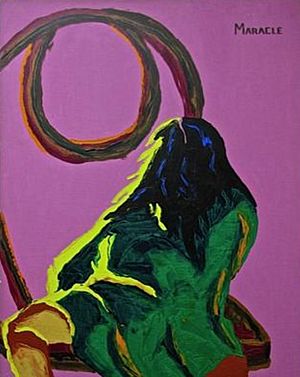Clifford Maracle facts for kids
Quick facts for kids
Clifford Maracle
|
|
|---|---|
| Born | 1944 Tyendinaga Reserve, Ontario, Canada
|
| Died | 1996 (aged 51–52) |
| Known for | painter, sculptor |
Clifford Lloyd Maracle (1944–1996) was an important Indigenous artist from Canada. He was a member of the Mohawk Nation from the Tyendinaga Reserve in Ontario. Clifford Maracle was both a painter and a sculptor. He became famous for his art that showed the difficulties faced by Indigenous people living in cities during the 1970s. Instead of using only traditional designs, Maracle created a new, expressive style. He became a leader for this modern art approach among First Nations artists.
Contents
Clifford Maracle's Early Life
Clifford Maracle was born in 1944 on the Tyendinaga Mohawk Territory Indian Reserve in Ontario, Canada. He grew up in a large family with 10 children. His family faced challenges, and they eventually left the reserve. These experiences likely made Maracle feel strongly about fairness and justice for his people.
Maracle went to East Elgin Secondary School. He later studied fine art at George Brown College. He earned an Honours Graduate degree from the Ontario College of Art in Toronto. He also took a Native Journalism course at the University of Western Ontario.
Clifford Maracle's Art and Style
Clifford Maracle used his art to express himself. Like other Canadian modern artists, he sometimes used Indigenous images and sometimes did not. This showed that art didn't always have to fit a certain idea of "authentically Indian."
Maracle was inspired by the American artist Fritz Scholder. He moved beyond the idea that all Indigenous artists only draw from myths and legends. Instead, his works often focused on political issues and new ideas. By challenging old ideas about "Indian Art," Maracle found new ways to show the important issues of his time. He helped people understand the complex realities of Indigenous life.
In 1984, he attached his Canadian Indian identity card to his painting "Changing Reserve." This was his way of showing the poor conditions in Canadian Indian reserves.
Many of Maracle's artworks showed movement. They often depicted Indigenous dancers, historical events, animals, or athletes. Maracle also used dark humor in his art. For example, his painting "The Plight of the Urban Indian" shows three figures. One has a wide-open mouth, another looks sad, and the third seems content. This painting showed how Indigenous people sometimes felt out of place or confused in a society that could be unfriendly.
Maracle's art has been shown in many group exhibitions since the 1970s. One notable show was "Oh So Iroquois," which was put together by Ryan Rice for The Ottawa Art Gallery.
Where You Could See His Art
Clifford Maracle's art was featured in many exhibitions.
Solo Exhibitions
- 1985 Clifford Maracle: Paintings and Sculpture - Galerie Dresdnere, Toronto, ON
- 1994 Hard Edge Psychological Revelation - Maslak McLeod Canadian Art, Santa Fe, NM
Group Exhibitions
- 1983 Indian Art '83 - Woodland Cultural Educational Centre, Brantford, ON
- 2007 Oh So Iroquois - Ottawa Art Gallery, Ottawa, ON
- 2010 Oh So Iroquois - Art Gallery of Southwestern Manitoba, Brandon, Manitoba
- 2012 Permanent Collection Spotlight – Thunder Bay Art Gallery, Thunder Bay, ON
- 2013 First People Land and Sky - Ingram Gallery, Toronto, ON
- 2013 First Nations Art 2013, Woodland Cultural Educational Centre, Brantford, ON
Art Collections
Clifford Maracle's artworks are held in several important collections. This means his art is kept and displayed in these places for people to see.
- Canadian Museum of History
- Confederation Centre Art Gallery
- Nickle Arts Museum, University of Calgary
- McMichael Art Collection
- Thunder Bay Art Gallery



